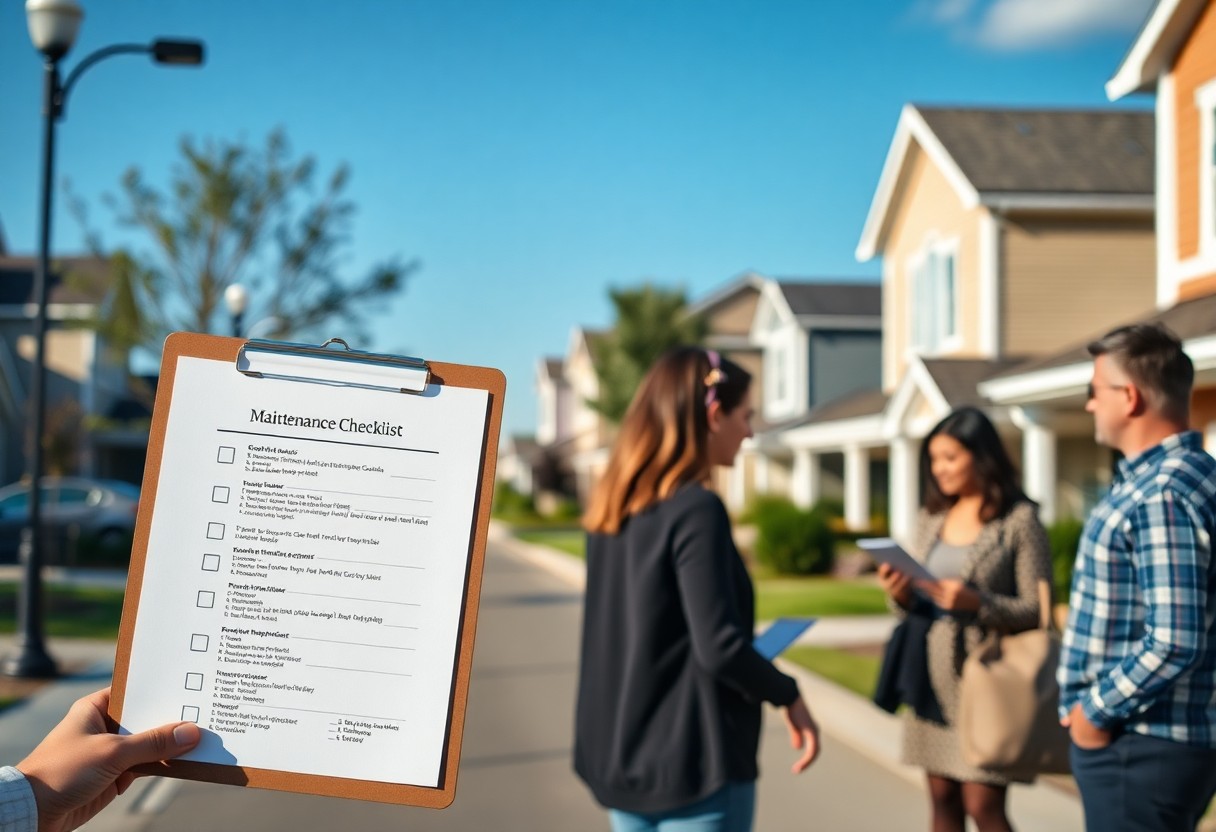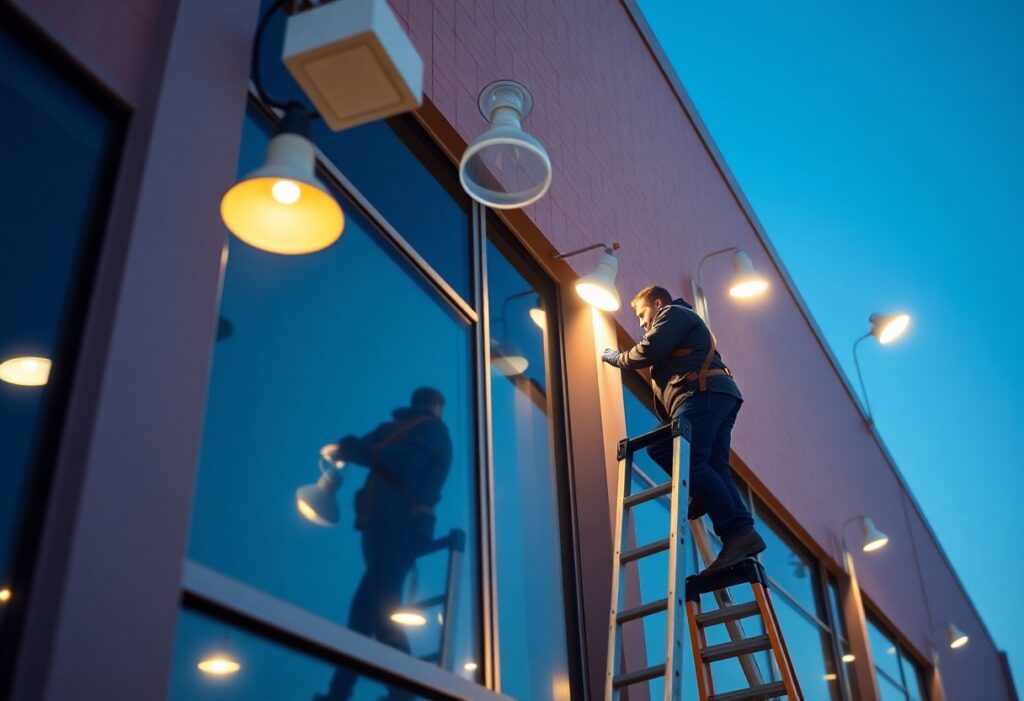Most homeowners association (HOA) boards understand the importance of well-maintained lighting for enhancing safety and aesthetics in your community. By establishing a comprehensive lighting maintenance plan, you can ensure that all areas are adequately illuminated, reducing liability and fostering a welcoming environment. This guide will walk you through the vital steps to develop a tailored maintenance strategy that addresses your specific needs, ensuring that you keep your lighting system in optimal condition year-round.

Key Takeaways:
- Assess current lighting needs by conducting a thorough evaluation of existing fixtures, their condition, and areas that may require additional lighting for safety and aesthetic purposes.
- Establish a regular maintenance schedule that includes inspections, repairs, and replacements to ensure all lighting elements are functional and maintain an inviting environment for residents.
- Engage with residents to gather feedback on lighting issues and preferences, fostering a sense of community involvement and ensuring the maintenance plan meets their needs effectively.
Understanding the Importance of a Lighting Maintenance Plan
While many HOA boards may overlook the significance of a lighting maintenance plan, it serves as a fundamental aspect of community management. Proper lighting not only ensures that your community remains safe and inviting but also enhances the overall quality of life for residents. A comprehensive maintenance plan can help you articulate the value of your neighborhood, while addressing the needs of your residents efficiently.
Enhancing Safety and Security
If your community’s lighting is inadequate or poorly maintained, it can create unsafe conditions for residents. A solid maintenance plan ensures that lights operate effectively, illuminating common areas and pathways. This visibility plays a pivotal role in deterring criminal activity and fostering a sense of security among your residents.
Improving Aesthetic Appeal
If you prioritize your community’s curb appeal, a consistent lighting maintenance plan can be transformative. Neatly illuminated spaces provide an inviting atmosphere that enhances the overall look and feel of your neighborhood.
It’s vital to consider that effective lighting can highlight architectural features and landscaping, showcasing the unique character of your community. When residents come home to a well-lit environment, it nurtures pride in their surroundings and encourages outdoor engagement.
Reducing Energy Costs
For many HOAs, energy costs can be a significant expense. By establishing a lighting maintenance plan, you can monitor and upgrade lighting systems to ensure they are energy-efficient.
Lighting plays a crucial role in energy consumption. Regular maintenance, such as replacing outdated fixtures and using LED bulbs, can drastically reduce electricity costs. Additionally, implementing smart lighting technologies allows for better control over energy usage, ensuring that only the necessary areas are illuminated when required.
Key Factors to Consider
It is important to evaluate several key factors when creating a lighting maintenance plan for your HOA. This includes types of lighting used, light pollution regulations, community needs and preferences, and budgeting and financial planning. Understanding these elements will help you ensure a sustainable and effective lighting system.
- Evaluate the condition and lifespan of current fixtures.
- Consider energy-efficient options like LED lighting.
- Account for areas needing enhanced illumination for safety.
- Plan for seasonal changes in lighting needs.
- Assess potential hazards in poorly lit areas.
Perceiving the significance of these factors will aid in formulating an effective and comprehensive maintenance plan.
Types of Lighting Used
One important aspect to consider is the types of lighting fixtures used throughout your community. Different areas may require specific lighting solutions, such as:
- Pathway and walkway lights to enhance safety.
- Decorative lights for aesthetic appeal.
- Security lighting for vulnerable areas.
- Pole lights for public spaces like parks.
- Smart lighting systems for efficiency.
Assume that variety, functionality, and energy efficiency are the primary goals when choosing lighting types.
| Factor | Description |
| Condition of Fixtures | Assess the state and effectiveness of existing lighting. |
| Energy Source | Determine if your community is best served by LED, solar, or traditional lighting. |
| Maintenance Schedule | Establish regular checks and balances for upkeep. |
| Compliance | Adhere to local regulations regarding lighting fixtures. |
Light Pollution Regulations
An increasingly important aspect of lighting maintenance is adhering to light pollution regulations. These guidelines seek to balance community safety and visibility with environmental conservation by minimizing excess light.
Another critical consideration is checking for local government calls for reduced brightness and shielding. Make sure your community’s lighting plan aligns with these regulations to avoid penalties while contributing positively to the night sky visibility for your residents.
Community Needs and Preferences
One effective way to create a well-rounded lighting maintenance plan is to take into account the needs and preferences of your community. Engaging residents through surveys can provide insights into their lighting desires, safety concerns, and aesthetic preferences.
A thoughtful plan will incorporate the feedback from your community members while providing ample illumination and ensuring safety in common areas. Addressing these preferences will foster a sense of ownership and satisfaction among residents.
Budgeting and Financial Planning
Clearly outlining your budgeting and financial planning is a vital step in your lighting maintenance strategy, encompassing initial costs, installation, upkeep, and potential upgrades.
Preferences for smart lighting technologies or energy-efficient options may require upfront investment, but the long-term savings can justify these costs. Make sure you provide a detailed financial outlook to your HOA board, highlighting potential returns on investment.
Developing Your Lighting Maintenance Plan
Once again, creating a robust lighting maintenance plan is important to ensuring the safety and aesthetics of your community. You can start by exploring options for Outdoor Lighting for Homeowners Associations that will suit your specific needs.
Assessing Current Lighting Infrastructure
Current lighting systems should be thoroughly evaluated to identify their condition and effectiveness. This assessment involves checking the type of lighting fixtures, their placement, and overall performance. Taking inventory of existing lighting resources will help you determine what needs replacement, repair, or upgrade.
Setting Maintenance Goals and Objectives
Lighting objectives should align with the needs of your community. This could include enhancing safety, reducing energy consumption, or improving the aesthetic appeal of common areas. Establishing clear goals will guide your maintenance plan and ensure all stakeholders are on the same page.
Setting these goals requires you to engage with your community members to understand their specific lighting needs and preferences. By establishing measurable and achievable objectives, you can prioritize tasks and allocate resources more effectively, ensuring that your maintenance efforts yield the desired results.
Scheduling Regular Inspections and Maintenance
Maintenance routines should include regular inspections to assess the functionality of lighting fixtures and to identify any issues early on. Creating a schedule for these inspections can help maintain the integrity of your lighting systems over time.
Plan to conduct inspections at least quarterly, and incorporate a checklist to document findings and actions taken. Regular maintenance not only extends the life of your lighting systems but also keeps your community safe and welcoming, demonstrating to residents that you care about the upkeep of common areas.
Implementing Effective Maintenance Strategies
For your HOA to maintain a safe and welcoming environment, implementing effective maintenance strategies for your lighting is crucial. This means aligning your approach with a solid maintenance plan that encompasses regular check-ups, repairs, and upgrades. You may want to explore the Essential Elements Of A HOA Lighting Contract to understand the components of an effective lighting strategy.
Choosing the Right Maintenance Service Providers
Now, selecting the right maintenance service providers can significantly impact the effectiveness of your lighting maintenance plan. Look for experienced professionals with a solid reputation and proven track record, as they will ensure timely repairs and replacement of faulty equipment.
Training HOA Staff on Lighting Maintenance
One of the vital elements to consider is training your HOA staff on proper lighting maintenance techniques. An informed staff can perform routine checks, identify issues early, and run basic troubleshooting to keep your community lit safely and efficiently.
Choosing a training program that covers various aspects of lighting maintenance is important. This should include understanding different types of lighting systems, simple repair techniques, and when to escalate issues to your preferred service provider. Knowledgeable staff enhances the overall effectiveness of your maintenance strategy.
Utilizing Technology for Monitoring
Assuming you want to streamline your maintenance processes, utilizing technology can play a significant role in monitoring your community’s lighting systems. Automated systems can alert you to potential issues before they become larger problems, ensuring that your lighting remains consistent and effective.
Effective use of technology includes implementing smart sensors and monitoring systems that track light performance and energy usage. This data not only helps you anticipate potential failures but also assists in making informed decisions regarding upgrades and energy savings, creating a more efficient and sustainable community lighting plan.
Tips for Ensuring Long-term Success
Unlike one-time fixes, a successful lighting maintenance plan requires ongoing attention and strategy. Implementing these tips can help you maintain a consistent and effective lighting system for your HOA:
- Regularly review and adjust your maintenance schedule.
- Engage residents in the maintenance sharing process.
- Utilize technology for monitoring and reporting issues.
- Assess lighting needs and adjust for seasonal changes.
- Conduct annual evaluations of safety and efficiency.
Perceiving the importance of an adaptive approach will keep your lighting maintenance plan thriving.
Establishing Clear Communication with Residents
One effective strategy is to set up regular communication channels with your residents. This includes newsletters, email updates, and community meetings where residents can voice their concerns or suggestions. Transparency fosters trust and encourages residents to be more engaged in the upkeep of your community’s lighting system.
Documenting Maintenance Activities
Residents benefit from your systematic documentation of maintenance activities, as it keeps everyone informed and aware of ongoing projects. This practice not only creates accountability but also helps identify recurring issues that may require more in-depth attention.
The documentation process may include keeping records of who performed maintenance, when it occurred, and what actions were taken. Using a digital platform can streamline this documentation, making it easy for you and your team to access and share important information. Regular updates will keep your residents connected to the status of the lighting maintenance efforts.
Creating an Emergency Response Plan
If an emergency arises, having a pre-established response plan can expedite the resolution process. It’s important to identify the key players involved and clarify their roles, ensuring that everyone knows how to act in various situations related to lighting maintenance.
Creating an emergency response plan involves outlining procedures for dealing with power outages, damaged fixtures, or safety hazards. Include contact information for vendors and local authorities to facilitate quick responses. Regularly reviewing this plan with your team and residents can help ensure everyone is prepared in the event of an emergency, minimizing disruptions in your community.
Reviewing and Updating Your Plan
Now that you have developed a lighting maintenance plan for your HOA, regularly reviewing and updating it is necessary to ensure its effectiveness. An effective way to stay on track is by referencing a comprehensive HOA Maintenance Checklist: Everything You Need to Know!. This will allow you to assess your current plan and make necessary adjustments.
Importance of Regular Reviews
Even though your lighting maintenance plan might seem effective initially, frequent reviews are necessary to adapt to any changes arising within your community and its lighting needs. Regular assessments enable you to identify areas for improvement and ensure that your resources are being utilized efficiently.
Adjusting for Changing Community Needs
Needs may shift over time due to new developments, changes in resident demographics, or advancements in lighting technology. This means your lighting maintenance plan should evolve to address these changes, ensuring it remains relevant and effective in serving your community.
Plus, staying mindful of your community’s growth and transformation can help you plan for future lighting requirements. For instance, if new residential areas or common spaces are created, consider adjusting your lighting plan to accommodate increased usage, improve safety, and enhance aesthetics throughout your HOA.
Incorporating Feedback from Residents
Assuming you gather input from residents regarding their concerns and suggestions, you can improve your lighting maintenance plan significantly. Engaging your community fosters collaboration and helps ensure that your plan meets their needs and expectations.
This feedback can be invaluable. Creating regular opportunities for residents to voice their opinions—whether through surveys, meetings, or suggestion boxes—empowers you to adapt your lighting maintenance strategy. By actively incorporating their input, you not only enhance resident satisfaction but skyrocket the effectiveness of your maintenance efforts.
Summing up
To wrap up, developing a lighting maintenance plan for your HOA involves assessing current lighting needs, setting a budget, scheduling regular inspections, and engaging reliable service providers. By staying proactive and organized, you ensure safety, enhance property aesthetics, and promote energy efficiency. Additionally, incorporating community input can lead to greater satisfaction among residents. Following these steps will help create a sustainable and effective lighting maintenance strategy tailored to your community’s specific requirements.
Q: What are the key components of a lighting maintenance plan for an HOA?
A: A comprehensive lighting maintenance plan for a Homeowners Association (HOA) should include several key components: regular inspection schedules, maintenance protocols, and a budget for repairs and replacements. Start by determining how often inspections should occur, such as quarterly or biannually, to assess the condition of all lighting fixtures. Document this schedule and outline specific maintenance tasks like cleaning fixtures, replacing burned-out bulbs, and checking electrical connections. Additionally, create a budget that accounts for both routine maintenance and unexpected repairs to ensure reliable lighting throughout the community.
Q: How can we effectively communicate our lighting maintenance plan to HOA members?
A: Effective communication of the lighting maintenance plan to HOA members can be achieved through various channels. Start by holding an informative meeting where board members can present the plan and address any questions. Follow up with a detailed newsletter or email that outlines the plan’s components, the importance of proper lighting, and the potential impact on safety and aesthetics within the community. Additionally, consider creating a dedicated section on the HOA website to keep members informed about updates, scheduled maintenance activities, and any associated costs, fostering transparency and engagement.
Q: What steps can we take to assess the effectiveness of our lighting maintenance plan?
A: To assess the effectiveness of your lighting maintenance plan, regularly review maintenance records and conduct follow-up inspections. Gather feedback from residents regarding the quality and reliability of the lighting in common areas. You may also want to establish performance metrics, such as the number of reported outages or complaints related to lighting. By analyzing this data, the HOA can identify areas for improvement and adjust the maintenance plan as necessary to enhance the overall effectiveness and satisfaction of the community’s lighting system.



